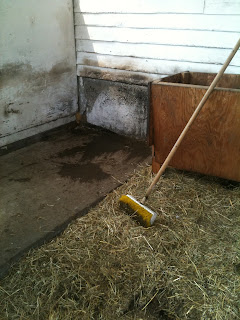
Of all the chores at Several Gardens Farm, barn cleaning has the least glamour. It's also easily put off. A barn that needs cleaning will still need cleaning another day.
Add to that, cleaning a barn on a damp day is an exercise in futility. It never dries properly, and dust, present even in the rains of winter, finds every sticky surface and leaves a layer of new filth over any efforts to clean it.
But if you can smell your barn, the animals smell it too. They have no choice; they can't go into the house because the barn smells bad.
So clean I must.
 Of course, animals produce waste. Chickens mostly poop at night. They sleep on roosts, and wake periodically to jettison their droppings onto the bedding below. There are a couple of choices for dealing with this.
Of course, animals produce waste. Chickens mostly poop at night. They sleep on roosts, and wake periodically to jettison their droppings onto the bedding below. There are a couple of choices for dealing with this.Soiled bedding can be removed daily and immediately moved into compost, or it can be deep-litter mulched, adding layers of bedding over the offending material. That's what we do. It means fewer cleaning days per year, but more work when cleaning finally happens. It also means the bedding is rich with nutrients when we finally take it out.
Goats do their business outside, wherever they happen to be. Goat poop is less obnoxious than chicken poop, but they pee a lot and over time their urine soaks into the wood chips near the barn. I am not going to clean those today because I need to order wood chips first.
 Goats and chickens gravitate toward dust for their personal grooming. Both species love to dust bathe, ruffling fine, dry dust through their coats or feathers to the skin, where it removes oils and destroys pests. But alas, it also gets all over fixtures and walls.
Goats and chickens gravitate toward dust for their personal grooming. Both species love to dust bathe, ruffling fine, dry dust through their coats or feathers to the skin, where it removes oils and destroys pests. But alas, it also gets all over fixtures and walls.There's nothing for it but to sweep smooth surfaces and then scrub them down and hose them. The dirt floor is shoveled and pitchforked free of bedding. Scrubbing a dirt floor won't work. Instead I sprinkle it with lime, which locks up the ammonia and kills odor. My friend Sheila contacted me out of the blue with a new bale of straw, perfect for bedding. Hay, which the goats eat, doesn't work as well. It gets soggy instead of letting moisture escape. Also, when we use it as mulch, it sprouts from the many seeds it shouldn't - but often does- contain.
Lightly soiled bedding get piled around plants as mulch. It isn't deep enough to kill all weeds below but it sets them back long enough to let the plants I want to grow.
The milking stand is scrubbed often, and sunned whenever possible. Here it is catching rays. I used to think the old farm management books that tell you how good sunshine is for this and that were obsolete. I would think 'yeah, that was before we had bleach and other strong cleaners'.
But then I got an aquarium with a UV sterilizer and started to think of the sun as the biggest ultraviolet radiation source in the solar system. Mine. For free. Now I use it to clean and bleach stuff all the time. Thank you sun.
When our bodies metabolize the nitrogen in proteins, ammonia is the very toxic byproduct. Fish wash their ammonia out quickly, using copious water. For land animals, water is precious, and we can't waste it cleansing ourselves of ammonia. So we convert the ammonia into the less toxic urea, and birds, reptiles and insects make the even more harmless uric acid - the white substance that makes bird droppings so recognizable.
When I learned about this in college, it was a revelation that kept me excited for days. Up until then, I had absorbed the notion that our bodies were filthy and that waste was a sign of how unpleasant we were. I had also learned to think of my body esthetically - as something that should be beautiful and smell good all the time.
Learning the wonderful chemistry of the urea cycle changed how I thought of the body. The gawkiest, nerdiest, homeliest of us all is still capable of these amazing metabolic feats. The idea that I had been doing this all my life without even knowing it blew me away.
Cleaning the barn gets me very close to this cycle again. The waste from the goats and chickens may smell bad, and my back may hurt. But the barn is clean and the animals are happy. And out in the farm, nitrogen is moving, into the compost pile, into the garden to help the plants grow.




2 comments:
I took several fibers classes in art school, and if I remember correctly, urea is used in certain fabric dyeing processes. I didn't know where it came from! Interesting!
Heidi, there are synthetic sources for urea; artists use some, farmers us a lot of it. And ironically, most of us flush the best source of all down the pipes!
Post a Comment